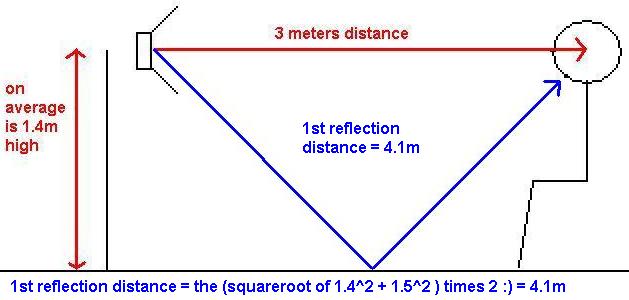 Malaysia
Boleh
Malaysia
Boleh 
How do sound reflect?
The answer is best shown by a video. Pictures paint a thousand words. It is very useful to be able to see sound at times. Well, to a certain extend. At least in this case one get to see where it is going.
Sound
reflections demo
The avi video file is 39.7MB large but is zipped and is now 6.99MB.
Takes a long time to download, so please be informed.
Acoustics/Intro_acoustics/Pictures/Acoustics_Ray_Tracing.zip
The avi shows a typical theater hall with single sound source. The source under simulation is projecting sound into one discrete direction only, which is going bottom in this demo. The reflection is then followed and one will see how sound reflect.
It is to be informed that the variables under investigation may be subject to clarification by watching the reflections taking place and noting the number of reflection steps on the top right window. The distance traveled by the reflection / singular sound, as well as time lapse used to travel the distance is also displayed.
The distance traveled normally follow suite to the room's reverberation time, RT60.
Please be aware, some surfaces are set to behave to reflect sound like mirrors (specular), while some are set to reflect randomly (scattering). Some surface may be set a percentage of specular as well as scattering, i.e. 30% specular, 70% scattering.
Some surface representing humans seating plus pews may be set to 100% scattering for frequencies above 200Hz, while 50% specular and 50% scattering at lower frequencies.
The simulation theory used is term as "Ray-Tracing", therefore to further explore into this subject, please look under / search for Acoustics Ray Tracing. Beam Tracing is also another well suited subject for study of acoustics.
Each surface representing different reflection / absorption behavior may be properly keyed-in for high accuracy.
While looking at the demo, please note that there are very little probability of sound striking at corners and edges. Perhaps audiophiles treating corners may not be very effective?
This do explain why treated corners room do not have significantly better acoustics. One should also realize that acoustics treatment to any area is subject to frequency, more importantly in this case, the wavelength.
If the wavelength under treatment has been found to be 250Hz, which is typical in a room, therefore the wavelength = speed of sound / frequency, which is 347.3/250 = 1.3892 meters long.
If the acoustic treatment size is smaller than 1.3892, then it would NOT be effective. Since not many people uses this, we may deduce most acoustic treatment are not effective.
The material used to absorb the problem reflection (not sound) is also a serious consideration, as well as thickness and pores size.
Now, please look at the video again and note that a singular sound source would have nearly filled the entire room, what happens in reality if it's a true 360 sound outward. Even more complicated!
Next topic
How many reflections are there?
The video would have answered the question. Therefore the topic should be rephrased as "How MUCH reflections are there?"
ACOUSTICS SECTION AUDIO SECTION CAR SECTION
HOME - Technical Website for Acoustics, Audio and Car
Now that you've seen the video, remember this?

So, for the sound to travel 3 m takes 3 / 347.3 = 8.6 ms
For the closest reflection = 1st reflection = 1st interference to original sound source = 4.1 m and it takes 4 / 347.3 = 11.5 ms
This means there is actually only 11.5 - 8.6 = 2.9 ms or PURE, real original sound
and hey, what happen to human's brain processing sound issue?
Human brains adopt around 35 ms of time window before processing it. This means in the 35 ms window, only 2.9 ms is pure, while 32.1 ms has invasion from reflections from all over the place, time and angle.
32.1 / 35 = 91.7 %
But wait, the music sound is continuous / non stop until it stops playing. Normal songs have an average time of 4 minutes, that's 4 x 60 x 1000 = 240,000 ms.
so, only the 1st 2.9 ms is considered the purest therefore 239,997.1 ms of invaded reflections time :(
so again 239,997.1 / 240,000 = 99.99879166666667% of the time humans are hearing sound in conjunction with reflections. Not pure.
For the case of Car Audio
Assuming right driver listening to right tweeter: -
direct sound path is around 0.5 m, assume reflection from ceiling, which has a traveling path around 0.7 m therefore
performing all the calculations as above..... it is also equivalent that 99.9999% of the time humans are hearing to sounds in conjunction with reflections. Not pure.